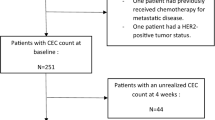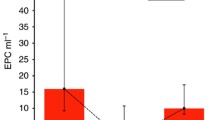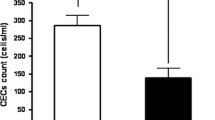Abstract
Background
Bevacizumab has shown consistent clinical efficacy in metastatic colorectal cancer (mCRC), but some patients respond better than others. Thus, it is crucial to identify biomarkers that permit the recognition of potentially responsive subjects and to spare toxicity in those who are unlikely benefit from treatment.
Methods
In 24 mCRC patients undergoing Bevacizumab-based first-line treatment, we assessed by multiparameter flow cytometry changes in circulating endothelial cell (CEC) number, their apoptotic fraction (APO-CEC) and their mutual relationship. Data were compared with those from a group of 21 healthy subjects.
Results
CECs and APO-CECs were higher in patients versus controls (p = 0.01 and p > 0.05, respectively). The increase in CECs at the 3rd cycle in complete response (CR) patients was statistically significant (p = 0.048). A better progression-free survival was evidenced in patients that showed an increase in CECs at the 6th cycle (p = 0.009). Regarding the changes in CECs and APO-CECs, a strong correlation was evidenced, at baseline, both in the global population (0.002; r: 0.53) and in the CR subgroup (p: 0.02; r: 0.77). In the partial response + stable and progression disease (SD + PD) subgroup, this correlation was highly significant at the 6th cycle (p: 0.001; r: 0.83).
Conclusions
We confirmed the predictive role of an increase in CECs in mCRC patients treated with Bevacizumab-based therapy and showed that modifications in CECs and APO-CECs are independent factors. This underlines the relevance of a simultaneous quantitative and functional evaluation of these biomarkers in view of their possible diagnostic utility.






Similar content being viewed by others
References
Anonimus (2002) World Medical Association Declaration of Helsinki: ethical principles for medical research involving human subjects. J Postgrad Med 48:206–208
Beerepoot LV, Mehra N et al (2004) Increased levels of viable circulating endothelial cells are an indicator of progressive disease in cancer patients. Ann Oncol 15:139–145
Bertolini F, Shaked Y et al (2006) The multifaceted circulating endothelial cell and cancer: towards marker and target identification. Nat Rev Cancer 6:835–845
Bertolini F, Mancuso P et al (2007) Molecular and cellular biomarkers for angiogenesis in clinical oncology. Drug Discov Today 12:806–812
Bertolini F, Mancuso P et al (2009) The multiple personality disorder phenotypes of circulating endothelial cells in cancer. Biochim Biophys Acta 1796:27–32
Bidard FC, Mathiot C et al (2010) Clinical value of circulating endothelial cells and circulating tumor cells in metastatic breast cancer patients treated first line with Bevacizumab and chemotherapy. Ann Oncol 21:1765–1771
Buyse M, Sargent DJ et al (2010) Biomarkers and surrogate end points-the challenge of statistical validation. Nat Rev Clin Oncol 7:309–317
Dellapasqua S, Bertolini F et al (2008) Metronomic cyclophosphamide and capecitabine combined with Bevacizumab in advanced breast cancer. J Clin Oncol 26:4899–4905
Duda DG, Ancukiewicz M et al (2010) Biomarkers of antiangiogenetic therapy: how do we move from candidate biomarkers to valid biomarkers? J Clin Oncol 28:183–185
Folkman J (1971) Tumor angiogenesis therapeutic implications. N Engl J Med 285:1182–1186
Goon PK, Boos CJ et al (2006) Detection and quantification of mature circulating endothelial cells using a flow cytometry and immunomagnetic beads: a methodological comparison. Tromb Haemost 96:45–52
Goon PK, Lip GY et al (2009) Circulating endothelial cells and circulating progenitor cells in breast cancer: relationship to endothelial damage/disfunction/apoptosis, clinicopathological factors and the Nottingham Prognostic Index. Neoplasia 11:771–779
Hurwitz H, Fehrenbacher L et al (2004) Bevacizumab plus irinotecan, fluorouracil, and leucovorin for metastatic colorectal cancer. N Engl J Med 23:2335–2342
Jain RK, Duda DG et al (2009) Biomarkers of response and resistance to antiangiogenetic therapy. Nat Rev Clin Oncol 6:327–338
Khan SS, Solomon MA et al (2005) Detection of circulating endothelial cells and endothelial progenitors by flow cytometry. Cytom B Clin Cytom 64:1–8
Mancuso P, Bertolini F (2010) Circulating endothelial cells as biomarkers in clinical oncology. Microvasc Res 79:224–228
Mancuso P, Burlini A et al (2001) Resting and activated endothelial cells are increased in the peripheral blood of cancer patients. Blood 97:3658–3661
Mancuso P, Colleoni M et al (2006) Circulating endothelial-cell kinetics and viability predict survival in breast cancer patients receiving metronomic chemotherapy. Blood 108:452–459
Mariucci S, Rovati B et al (2009) A six-colour flow cytometric method for simultaneous detection of cell phenotype and apoptosis of circulating endothelial cells. Scand J Clin Lab Invest 69:433–438
Mariucci S, Rovati B et al (2010) Flow cytometric detection of circulating endothelial cells and endothelial progenitor cells in healthy subjects. Int J Lab Hematol 32:40–44
Martin-Padura I, Bertolini F (2009) Circulating endothelial cells as biomarkers for angiogenesis in tumor progression. Front Biosci (Schol Ed) 1:304–318
McShane LM, Hunsberger S et al (2009) Effective incorporation of biomarkers into phase II trials. Clin Cancer Res 15:1898–1905
Norden-Zfoni A, Desai J et al (2007) Blood-based biomarkers of SU11248 activity and clinical outcome in patients with metastatic imatinib-resistant gastrointestinal stromal tumor. Clin Cancer Res 13:2643–2650
Ranieri G, Patruno R et al (2006) Vascular endothelial growth factor (VEGF) as a target of Bevacizumab in cancer: from the biology to the clinic. Curr Med Chem 13:1845–1857
Ronzoni M, Manzoni M et al (2010) Circulating endothelial cells and endothelial progenitors as predictive markers of clinical response to Bevacizumab-based first-line treatment in advanced colorectal cancer patients. Ann Oncol 21:2382–2389
Rowand JL, Martin G et al (2007) Endothelial cells in peripheral blood of healthy subjects and patients with metastatic carcinomas. Cytometry A 71A:105–113
Strijbos MH, Gratama JW et al (2008) Circulating endothelial cells in oncology: pitfalls and promise. Br J Cancer 98:1731–1735
Torrisi R, Bagnardi V et al (2008) Preoperative Bevacizumab combined with letrozole and chemotherapy in locally advanced ER- and/or PgR-positive breast cancer: clinical and biological activity. Br J Cancer 99:1564–1571
Welch S, Spithoff K et al (2010) Bevacizumab combined with chemotherapy for patients with advanced colorectal cancer: a systematic review. Ann Oncol 21:1152–1162
Wierzbowska A, Robak T et al (2008) Kinetics and apoptotic profile of circulating endothelial cells as prognostic factors for induction treatment failure in newly diagnosed acute myeloid leukemia patients. Ann Hematol 87:97–106
Zhu AX, Sahani DV et al (2009) Efficacy, safety and potential biomarkers of sunitinib monotherapy in advanced hepatocellular carcinoma: a phase II study. J Clin Oncol 18:3027–3035
Acknowledgments
The present work was partly supported by a Research Grant (Number 08010901/09 to M. Danova) from the Fondazione IRCCS Policlinico S. Matteo—Pavia. We wish to thank all the volunteers and patients for taking part in the study, as well as the nursing and the medical staff of each involved Clinical Institution for their support in the acquisition of clinical samples. A special thanks to Laurene Kelly for revision of the English.
Conflict of interest
The authors declare that they have no direct or indirect financial or personal relationship with other people or organizations that could bias their work. No benefits in any form have been received from a commercial party related directly or indirectly to the subject of this article.
Author information
Authors and Affiliations
Corresponding author
Rights and permissions
About this article
Cite this article
Manzoni, M., Mariucci, S., Delfanti, S. et al. Circulating endothelial cells and their apoptotic fraction are mutually independent predictive biomarkers in Bevacizumab-based treatment for advanced colorectal cancer. J Cancer Res Clin Oncol 138, 1187–1196 (2012). https://doi.org/10.1007/s00432-012-1190-6
Received:
Accepted:
Published:
Issue Date:
DOI: https://doi.org/10.1007/s00432-012-1190-6




